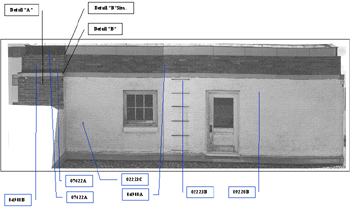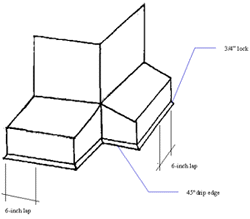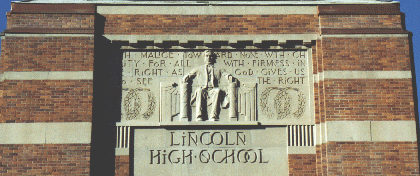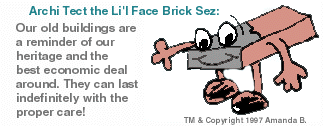| Analyze
Dimensionmate utilized the special research report prepared by Building Research Institute of Montana. The
owner's ideas and criteria were incorporated into the analysis and the scope of work was
agreed upon. The owner rejected the idea of a new roof and gutter called for by the
research report because of a limited budget.
Design
The copper flashing details for this unique job were designed
following the guidelines from the Copper in Architecture Handbook; Copper Development
Association. Hand sketches quickly illustrated the many complex shapes required for a
watertight installation.
It was determined the budget would not allow the entire
masonry surface to be restored. To honor the budget and still get the job done a strategy
was devised on what was to be done and how it was to be bid.
To repoint the brick and limestone and replace spalled and
broken brick, areas that were most critical were estimated and included in the documents
to allow all bidders an absolute quantity to bid on.
A contingency was included in the budget to allow for
additional work, during the course of the project, in case the architect and the mason
discovered it to be necessary. Unit prices asked for on the proposal form were used to
avoid arguments.
All masonry areas were slated for cleaning but the bidding
documents stated exactly how to clean the brick and limestone and how much cleaning was to
be done. The contractors were told they were not responsible for removing all stubborn
stains if they followed the procedures outlined in the bid documents.
Specifying cleaning this way alleviates a burden on the
contractor. They do not have to go over the masonry time and time again to "make it
right".
If responsibility for removing every stain falls on the
contractor, they will have to pad their bid to make sure their labor, materials and
equipment are covered. The owner in this case simply did not have the budget to make this
requirement and expect the price to come in low.
The owner opted to make it acceptable - not perfect. In some
areas the stubborn stains were not removed completely but this was viewed as a good
compromise rather than the alternative of not doing the project at all.
Document
Computerized specifications using
Speclink. Always up to date and maintained by professional specifications experts and
edited by experienced architects.

Computerized photo-drawings with Microsoft Powerpoint are
quick and compatible with most districts' electronic files. Keynotes allow changes quickly
without major revisions to documents.

Hand sketches for copper details are quick, inexpensive and
informative allowing the project to be bid without guesswork. The hand sketches originally
done during design were used to prepare the construction documents with minor additions.
This saves time and money.
Administer
Worked with general contractor reviewing a list of acceptable
substitute brick masons when the original bidding mason declined to accept the job after
the bid. Worked closely with new mason. Outer wythe of west wall had to be partially taken
down. After loose stucco was removed it was determined the mortar was too deteriorated.
The mason elected to clean the face brick taken down from
this wall and use them for the replacement brick on the other elevations. If this brick
had not been available, new modular brick that wouldn't match in size or color would have
been used. This area of west wall was replaced with new modular brick and stucco.

Photo of South Elevation of Lincoln Center after restoration.
Questions, Answers, and Lessons to be Learned
Q: Why did the original mason back out
of the bid?
A: There is a shortage of qualified masons
in this area and a mini building boom going on with many large masonry projects. These
projects quickly use up all the commercial masons experienced in this type of restoration.
The general contractor asked a residential mason to bid who had never done this type of
work. He quickly learned it was a very difficult project; high in the air at a very busy
downtown street with little room to maneuver and a limited staging area.
Example: A 110-foot manlift was at its maximum extension
trying to reach the farthest corners.
Lesson: Pre-qualify bidders. Do this well
before they are needed. Do not wait for emergencies to take care of restoration work that
could be done more easily and with less expense if planned for in advance.
Q: Why was the stucco applied to the new
modular brick on the west wall?
A: Only half of the west wall was torn down
and rebuilt. The rest of the wall still had stucco that was very difficult to remove. The
budget did not allow the removal of all the stucco, just the loose material. To stay
within our budget there was no choice but to prepare a solid substrate and apply stucco
again to the same area.
Lesson: Do not apply stucco or paint (or
steel siding for that matter) to brick that need restoration. It traps moisture in the
masonry assembly and accelerates the deterioration process. It compounds the problems for
the future restoration of the building and increases costs.
To Learn More
Read/Contact
Masonry Design and Detailing, Christine Beall, McGraw-Hill 1987
Copper Development Association
Brick Institute of America
Indiana Limestone Institute
Building Research Institute of Montana
.

|